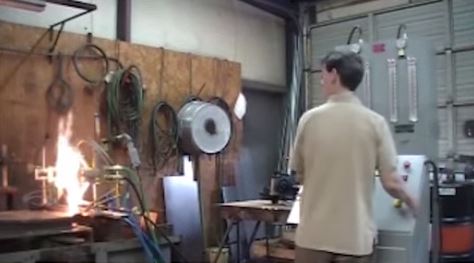Safety and Flame Hardening, Part 2

Understandably, some clients are nervous about using fuel gas and oxygen to create flame. You simply have to design flame hardening equipment to mitigate the risks associated with them.
Ignition and shutoff usually induce the most anxiety in operators. Our machines are designed so that operators must use two hands on opposite sides of the control panel for ignition, eliminating the possibility of body parts being anywhere near the flame during ignition.
We also have many ways of introducing more levels of control in the ignition process. It’s critical that the flow of oxygen be introduced properly into the flow of fuel gas. If you introduce oxygen too early or at too high a rate you can experience flashback and backfire. We control flows with regulators, valves, and solenoid valves, and design the process in whichever way the client is most comfortable. That includes options such as:
1) delay the introduction of oxygen on startup and kill the oxygen first during shutoff;
2) slow the opening and closing of the oxygen valve;
3) include a high/low oxygen setting, where startup and shutdown uses the low setting and operation uses the high.
All of these options reduce the amount of flame produced when introducing or shutting down the oxygen flow.
Another concern clients express about fuel is the danger of undetected fuel gas escaping from the valves. You can’t have gas leaks, obviously. We install a sensor “fire eye” on all of our equipment which makes sure neither fuel nor oxygen escapes without being in the ignition process. We also impress upon clients the importance of using a fuel gas that’s as stable as possible. Unstable gas like acetylene makes it difficult to achieve flow rates at high volume to keep the fuel/oxygen mixture consistent and stable. We like to see clients use propane or natural gas, which have stable properties and consistent delivery flows.
Other than open flame and fuel issues, the next issue most clients raise about flame hardening is the decibel level of the machines. No doubt about it, running a high rate and high volume of fuel gas and oxygen through the machine gives off high levels of decibels. In large applications we have installed machines within soundproofing walls or containment areas, where operators ignite from outside the containment area. Even in these cases we still recommend hearing protection for all operators and workers within the immediate vicinity of the machine. The flow rates that get the temperatures we need simply produce decibel levels that require protection during operation.
While ear protection is mandatory, however, eye protection is not. Operators who must tend a process – for example, an application that requires progressive flame hardening – and who must look at the flame for long periods, are not at risk for burns or injury to the eyes. Other applications don’t even require operators to look at the flame at all during operation.
The last concern we hear from clients involves the secondary heat generated by flame hardening equipment. When heating with open flame you are going to add heat to your environment. We work with clients to mitigate this issue by designing means to pull the heat away, such as with a hood and a fan that vents heat to the outside. Installing flame hardening equipment in a more spacious setting also helps to trap less heat. So do high ceilings. Too, if you make sure flow rates are producing as neutral a flame as possible (not fuel-rich), it reduces the amount of secondary heat significantly.
Well, this ends up my longest blog post, a two-parter, but that seems fitting: we pay a LOT of attention to safety concerns. Clients’ success depends on their comfort with and confidence in our equipment; and our success depends on our clients’ success. We take safety as seriously as they do, and build and run our own equipment in our own shop to make sure we understand the client experience.
Next week we’ll start talking applications and design, which will take all nine of these previous posts and put them into real-life applications that create a cost-effective, safe, and quality flame hardening solution. As always, if you want to ask me about heat treating or flame hardening, email me at mark@flametreatingsystems.com or call 919-956-5208.
B9: We want to know your opinion.






